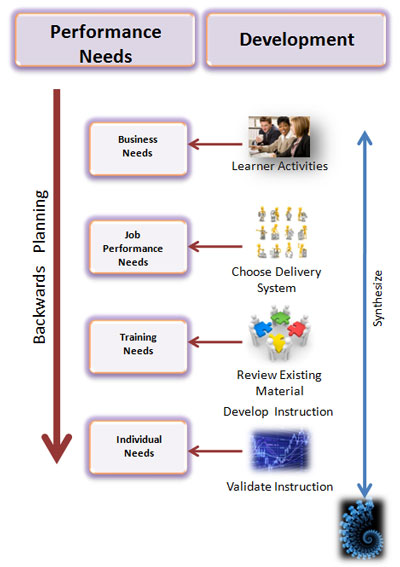Note: This site is moving to KnowledgeJump.com. Please reset your bookmark.
Review Material in Instructional Design
 The third step in the Development phase is to review any existing material to see if it can be adopted or redesigned into the learning process. This not only includes material developed in-house, but also material developed by third parties.
The third step in the Development phase is to review any existing material to see if it can be adopted or redesigned into the learning process. This not only includes material developed in-house, but also material developed by third parties.
Whenever possible, the duplication of materials should be avoided to save resources. Also, you should review any existing material relative to the new learning platform to see if it needs to be updated or discarded.
Care should be taken not to select material just because it is available. For example, there are probably several thousand instructional VCR tapes floating around that were developed during the 1980s and 1990s, not because they were the best media or methods for presenting the instruction; but because a camera and VCR were readily available at the time and everyone wanted to get in on this new technology. This same phenomenon occurred during the early stages of elearning when PowerPoint slides were adapted to elearning.
Reusable Information Object (RIO)
 A Reusable Information Object or RIO is granular chunk of information that is capable of being used again and is ideally created to be delivery media independent (Barritt, Lewis, Wieseler, 1999). The idea is to design and develop a RIO only once so that it can then be used in a number of learning applications. Each RIO is a collection of content items, practice items, or assessment items that are combined based on a single learning objective.
A Reusable Information Object or RIO is granular chunk of information that is capable of being used again and is ideally created to be delivery media independent (Barritt, Lewis, Wieseler, 1999). The idea is to design and develop a RIO only once so that it can then be used in a number of learning applications. Each RIO is a collection of content items, practice items, or assessment items that are combined based on a single learning objective.
Reusable Learning Object (RLO)
Individual RIOs are then combined to form a larger module, normally a lesson, called a Reusable Learning Object (RLO). An RLO is normally composed of content items, practice items, and assessment items.
Training courses have traditionally been built as large, monolithic processes that are difficult to repurpose into searchable learning objects for reuse in other learning platforms. Whereas an RIO/RLO strategy addresses this problem by designing content into smaller objects that can then be repurposed when needed. The goal is to create small chunks of information that helps learners to build knowledge and skills and then be able to use these “chunks” in other learning platforms when needed so as not to reinvent the wheel.
The Heart of Good Instructional/Learning Design
While the selection of the RLOs is often about applying them to SCORM or AICC standards, the primary reason for learning objects is to provide the best learning environment that supports the Agile Learning Design Ethos— “Solutions that promote and speed the development of learning processes over comprehensive documentation.”
While the selection process might seem rather mundane at first, it's more or less the heart of good design. This means chunking the contents into the most logical units that promote and speeds the learners' ability to learn and perform, and then packaging the content into various media that provide the best delivery methods. Thus, rather than breaking the material down into the smallest possible objects and tagging it for future reuse, they should be designed with the learners first in mind.
References
Barritt, C., Lewis, D., Wieseler, W. (1999). Cisco Systems Reusable Information Object Strategy: Definition, Creation Overview, and Guidelines. Version 3.0. Retrieved from: http://www.cisco.com/warp/public/779/ibs/solutions/learning/whitepapers/el_cisco_rio.pdf
Clark, R. (1989). Developing Technical Training: A Structured Approach for the Development of Classroom and Computer-Based Instructional Materials. Performance Technology Press.
Next Steps
Go to the next section: Develop Instruction
Return to the Table of Contents
Pages in the Development Phase
